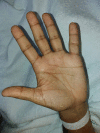Addison's Disease: A Diagnosis Easy to Overlook
- PMID: 33747659
- PMCID: PMC7970155
- DOI: 10.7759/cureus.13364
Addison's Disease: A Diagnosis Easy to Overlook
Abstract
Addison's disease is a rare and potentially life-threatening clinical condition that often presents with an insidious onset of nonspecific symptoms and signs, frequently resulting in a significant delay in diagnosis. Clinical presentation usually includes fatigue and electrolyte imbalance disorders such as hyponatremia. However, specific diagnostic features, such as hyperpigmentation, should raise clinical suspicion. This case report describes a 43-year-old Caucasian male who presented with general malaise, fatigue, anorexia, and weight loss (7 Kg in four weeks). On physical examination, he was found to have severe hyperpigmentation of the skin and mucosal surfaces as well as hypotension. Laboratory tests revealed hypoosmolar hyponatremia and serum potassium levels in the upper limit of normal. Findings of high serum adrenocorticotropic hormone (ACTH) and renin, as well as low cortisol and aldosterone levels, helped establish a diagnosis of Addison's disease. After the initiation of treatment, the patient experienced full recovery of symptoms, normalization of hyponatremia, and improvement of hyperpigmentation. Patients with Addison's disease have the potential to resume normal daily activities with a highly functional status. However, this condition requires lifelong follow-up and surveillance.
Keywords: addison disease; hyperpigmentation; hyponatremia.
Copyright © 2021, Mosca et al.
Conflict of interest statement
The authors have declared that no competing interests exist.
Figures
Similar articles
-
COVID-19 and Adrenal Insufficiency: Unmasking the Link.Cureus. 2023 Oct 29;15(10):e47920. doi: 10.7759/cureus.47920. eCollection 2023 Oct. Cureus. 2023. PMID: 38034146 Free PMC article.
-
Addison's disease in Africa--a teaching hospital experience.Clin Endocrinol (Oxf). 1999 Jan;50(1):115-20. doi: 10.1046/j.1365-2265.1999.00625.x. Clin Endocrinol (Oxf). 1999. PMID: 10341864
-
Coronary artery disease in a patient with Addison's disease: a case report and literature review.BMC Cardiovasc Disord. 2023 Jan 29;23(1):54. doi: 10.1186/s12872-023-03079-0. BMC Cardiovasc Disord. 2023. PMID: 36709280 Free PMC article. Review.
-
Challenges in Diagnosing Addison's Disease: A Case Report.Cureus. 2024 Sep 25;16(9):e70178. doi: 10.7759/cureus.70178. eCollection 2024 Sep. Cureus. 2024. PMID: 39463632 Free PMC article.
-
Addison's disease.Clin Dermatol. 2006 Jul-Aug;24(4):276-80. doi: 10.1016/j.clindermatol.2006.04.006. Clin Dermatol. 2006. PMID: 16828409 Review.
Cited by
-
Diagnostic Role of Tomography in Addison's Disease due to Adrenal Tuberculosis: A Case Report.Endocr Metab Immune Disord Drug Targets. 2025;25(5):421-427. doi: 10.2174/0118715303305534240709115115. Endocr Metab Immune Disord Drug Targets. 2025. PMID: 39075959
-
COVID-19 and Adrenal Insufficiency: Unmasking the Link.Cureus. 2023 Oct 29;15(10):e47920. doi: 10.7759/cureus.47920. eCollection 2023 Oct. Cureus. 2023. PMID: 38034146 Free PMC article.
References
-
- Consensus statement on the diagnosis, treatment and follow-up of patients with primary adrenal insufficiency. Husebye ES, Allolio B, Arlt W, et al. J Intern Med. 2014;275:104–115. - PubMed
-
- An update on Addison's disease. Barthel A, Benker G, Berens K, et al. Exp Clin Endocrinol Diabetes. 2019;127:165–175. - PubMed
-
- Autoimmune Addison's disease - an update on pathogenesis. Hellesen A, Bratland E, Husebye ES. Ann Endocrinol (Paris) 2018;79:157–163. - PubMed
-
- An Addison disease revealed with a serious hyponatremia. Maguet H, Carreau A, Hautefeuille S, Bonnin P, Beaune G. Ann Biol Clin (Paris) 2017;75:87–91. - PubMed
-
- The natural history of autoimmune Addison's disease with a non-classical presentation: a case report and review of literature. Manso J, Pezzani R, Scarpa R, Gallo N, Betterle C. Clin Chem Lab Med. 2018;56:896–900. - PubMed
Publication types
LinkOut - more resources
Full Text Sources
Other Literature Sources


